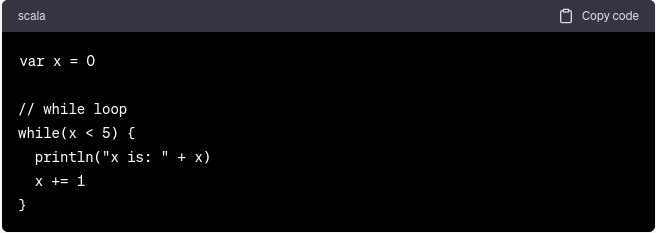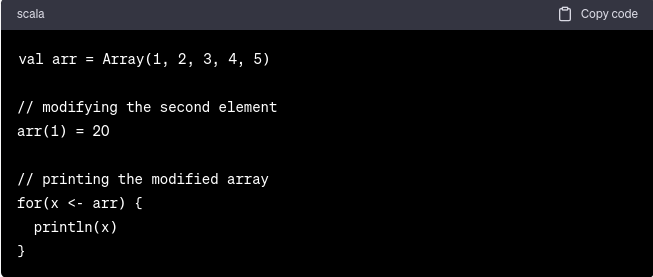Introduction
In this Scala tutorial, we're going to embark on a journey to explore the exciting world of Scala programming. No matter your experience, this article is designed to guide you through Scala's fundamentals. This makes it especially handy as a Scala tutorial for Python programmers. By the end of this guide, you will have a robust understanding of the Scala language, its practical applications, and how to navigate the Scala compiler.
Overview
Scala, short for "Scalable Language," was designed to grow with the demands of its users. It incorporates object-oriented and functional programming paradigms, providing developers with a high level of flexibility and power. As such, learning the Scala language can open up a world of programming possibilities for you.
What is Scala?
Scala is a modern, high-level programming language that integrates functional and object-oriented paradigms seamlessly. It runs on the Java Virtual Machine (JVM) and is fully interoperable with Java, allowing for efficient coding and a broad range of functionality.
This combination makes Scala a strong choice for everything from scripting to web development and advanced data analytics.
Consider the following simple example of a Scala program.

When you run this program through the Scala compiler, it prints "Hello, world!" to the console.
Scala Program Example
To showcase the elegance of Scala programming, let's write a program that calculates the factorial of a number.

This program will output `120`, which is the factorial of `5`. Scala can handle recursive function calls efficiently and intuitively, which is one of the many perks of using this language.
Where to Use Scala?
A question new learners commonly ask is, What is Scala used for? To address that, we must examine Scala's many applications, which benefit from its hybrid object-oriented and functional programming and Java interoperability.
Big Data Processing
Big Data has increased the need for languages that can efficiently manage huge amounts of data and complex activities. Memory efficiency and parallelization make Scala ideal for Big Data processing. Apache Spark, a popular Big Data tool, is written in Scala and works well with large data sets.
Web Development
Scala is a sophisticated web-building tool and number cruncher. Scala frameworks like Play and Lift are popular for backend development. The frameworks' asynchronous processing and productive environment make web development easy and efficient.
The Concurrent and Distributed System
Software engineers struggle with concurrent and distributed systems. But Scala's Futures and Akka make these tasks easier. Asynchronous, non-blocking Scala futures allow actions to be taken without waiting for previous activities to finish. Akka, a toolkit and runtime for building highly concurrent, distributed, and resilient message-driven applications, handles complex systems using Scala.
Finance
Financial institutions handle complex algorithms and data. Scala's fast performance and small syntax allow these institutions to analyze massive volumes of data quickly and accurately.
E-commerce
E-commerce platforms handle heavy traffic and complex backends. Backends at Walmart and Amazon use Scala to address these needs. Scala's concurrency architecture and Java codebase integration make it popular in this industry.
Analytical Data
Functional programming and efficient handling of large data sets make Scala a popular data analytics language. Scala allows Data Analysts to focus on analytics by writing high-level code that abstracts many low-level features. Data analysis, mining, and Machine Learning are rapid with it.
Scala is gaining popularity in scientific computing and data-intensive applications. Science and Statistics use Breeze and ND4J (N-Dimensional Arrays for Java) data structures and techniques.
Software Infrastructure
Scala is used to write many software tools and infrastructure components because of its flexibility and robustness. Open-source distributed event streaming infrastructure Apache Kafka is built in Scala.
Fundamentals of Scala
Let's delve deeper into some fundamental concepts of the Scala language.
Mutable Variables
Mutable variables can be changed after being assigned a value. Programmers use them to store and alter data. Scala declares mutable variables using the `var` keyword. Adjustable variables allow programming flexibility. Mutability lets a variable adapt to time or program conditions. A configurable counter should increment with each loop iteration.

This will output `20`, as we reassigned the value of `x`.
Although mutable variables offer flexibility, they can introduce uncertainty into a program. In complex scenarios, particularly concurrent operations, monitoring changes to mutable variables can be difficult. This may result in bugs or unforeseen outcomes.
Immutable Variables
Immutable variables refer to variables whose values cannot be changed once they are assigned. Modifying the value will lead to a compile-time error. In programming, immutability is a property that can be applied to certain data types, such as strings.
In Scala, immutable variables are declared using the `val` keyword.

This program will output `30`. If you try to reassign `y` to a new value, the Scala compiler will throw an error, demonstrating the immutability of `val`.
Immutable variables' predictability is certain. Their fixed values after initialization improve code readability. Reduced errors and improved code safety are possible in multithreaded contexts.
Beware of immutable variables’ limitations. They should not be used when circumstances or procedures require a variable to change.
Scala Tutorial For Python Developers
Scala, a statically typed language that mixes functional and object-oriented programming paradigms, may seem distinct from Python, a dynamically typed language known for its simplicity. However, Python programmers can identify parallels that make learning Scala easier and the unique characteristics that make it beneficial for certain applications.
Python and Scala Similarities
Both Scala and Python share numerous key concepts:
1. OOP: Both languages support OOP. Python programmers may immediately apply their class, object, inheritance, and polymorphism skills to Scala.
2. Functional Programming: Both languages support functional programming to differing degrees. Lambda functions and list comprehensions are limited in Python. Functional programming, higher-order functions, immutable data, and pattern matching are all in Scala.
3. Readability and simplicity: Python is famous for its usability. Despite its mixed nature, Scala strives for short, expressive syntax to reduce boilerplate and improve readability.
Switching from Python to Scala
Python programmers moving to Scala should be aware of the following important differences.
1. Static Typing: Scala is statically typed, unlike Python. This implies variable data types are checked at compile time, which can catch errors before the code is executed.
2. Variability: Python provides immutable data types like tuples and strings, while Scala encourages the use of immutable data and pure functions without side effects.
3. Concurrency Support: Python's Global Interpreter Lock (GIL) may slow multi-threaded applications. Akka's concurrency feature makes Scala better for parallel and concurrent processing.
Scala Training as a Python Programmer
1. Learn the Basics: Learn Scala grammar, data types, control structures, function, and class definition syntax. This will help you understand more about the language.
2. Know the Functional Paradigm: Scala's functional programming features are immutability, higher-order functions, currying, and tail recursion.
3. Explore Libraries and Frameworks: Scala has several libraries and frameworks for various uses. Web applications use Play Framework, Apache Spark for large data processing, and Akka for concurrency and distributed systems.
4. Practice: Finally, code Scala. Start with simple problems and progress to more challenging ones. Scala programming helps you learn and master the language.
The path from Python to Scala is one of discovering new paradigms and concepts. Accept the journey, and you'll discover that you can use the best of both worlds in your programming jobs over time.
Important Concepts of Scala
Decision-Making in Scala
Scala uses control flow expressions like `if`, `else if`, and `else` to make decisions, similar to other programming languages. The `if-else` construct evaluates a Boolean statement and runs code blocks accordingly. In Scala, the `match` statement is more powerful than a switch statement in other languages. It can match intricate patterns, types, and structures.
Example:

In this example, the output will be ‘x is not less than 20’ because the value of x is greater than 20.
Scala also has a match statement, which is a more powerful version of switch statements found in other languages. An example would be:

In this example, Scala's `match` expression checks the value of `day` and prints a corresponding message: "Start of work week" for "Monday", "End of work week" for "Friday", and "Mid of work week" for any other day.
Loops in Scala
1. while loop: Scala's while loop repeats a block of code while a condition is true, like other languages.
Example:

In the above while loop example, the loop will print x is: 0, x is: 1, x is: 2, x is: 3, x is: 4, and then terminate.
2. do-while loop: Like the while loop, the do-while loop examines the condition after the loop block is executed, ensuring it is carried out at least once.
Example:

This do-while loop prints "x is: 0", "x is: 1", and "x is: 2" by incrementing the value of x until it is no longer less than 3.
3. for loop: Scala has a more flexible for loop than many other languages. Iterates through strings, ranges, and collections. It supports the `yield` keyword for collection generation, guards (if clauses) for filtering, and nesting multiple loops.
Example:

This Scala code prints "x is: " followed by numbers from 0 to 4 using a `for` loop.
Arrays in Scala
An array in Scala is a modifiable, indexed sequence of same-type elements. Scala implements arrays as instances of the `Array` class. They access elements by index quickly and consistently. They Access and modify array elements using parentheses, `()`, and index.
Scala offers `ArrayBuffer`, a dynamically growing and shrinking mutable indexed sequence, in addition to `Array`. When the array's size is unknown or may change, you can use it.
Scala has powerful tools for manipulating arrays, including `map`, `filter`, and `reduce`. This enables efficient and expressive array manipulation.
Example:

In this example, we first declare an array arr with elements 1, 2, 3, 4, 5. Then we modify the second element of the array (index 1) to be 20. Finally, we print the elements of the array, resulting in 1, 20, 3, 4, 5.
Conclusion
Scala offers a wide range of benefits to both beginners and experienced programmers thanks to its versatility and reliability. This Scala tutorial gives you a solid understanding of Scala, including its uses, application areas, and important programming constructs. As you embark on your journey, always keep in mind that the Scala language is more than just a tool; it is a formidable ally that can help you tackle intricate programming tasks.
FAQs
1. Which is easier to learn, Scala or Python?
Python is more difficult to master than Scala. Python creates additional labour for the interpreter at runtime. Scala does not produce any additional work, making it 10 times faster than Python. Python makes data type decisions at runtime.
2. How does Scala handle nulls?
Scala opposes null values and recommends using the Option type to handle missing data. Some and None are Option subclasses. If a value is present, it is wrapped in Some; otherwise, it is None. This method simplifies missing values and prevents NullPointerExceptions.
3. How does Scala allow lazy evaluation?
Lazy evaluation implies that expressions are evaluated only when needed. This can improve performance, especially with huge data structures or computationally expensive processes. Scala delays variable initialization until it's first accessed when a variable is lazy.
4. Which IDEs Support Scala?
Scala is supported by a number of major Integrated Development Environments (IDEs). IntelliJ IDEA is a popular one for Scala development, and it has a specific plugin that provides features such as syntax highlighting, code completion, and refactoring. Eclipse also supports Scala via the Scala IDE plugin. Scala support is also available through extensions in lightweight text editors like Sublime Text, Atom, and Visual Studio Code.


-7f4b4f34e09d42bfa73b58f4a230cffa.webp&w=128&q=75)
-7f4b4f34e09d42bfa73b58f4a230cffa.webp&w=128&q=75)


























-ae8d039bbd2a41318308f8d26b52ac8f.svg)
















